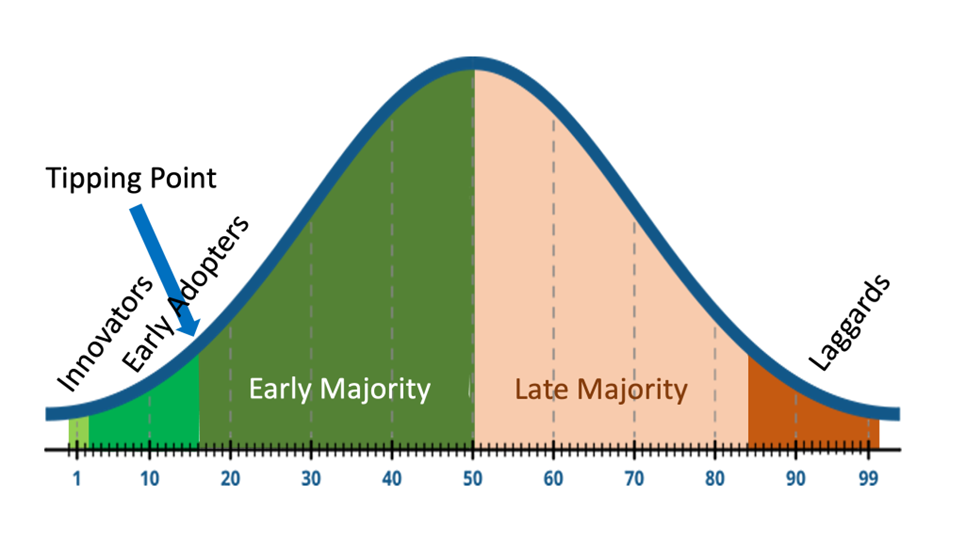Gaining Competitive Advantage using industry 4.0
A little while ago, I was on a live webinar with Simon Sinek, you know, the "Start With Why" guy. I'm a fan of his books and talks, which have substantially helped me in my business as well as my coaching role.
It reminded me of a model I came across in his earlier work, which is about how an idea or innovation travelled through society at large. It made so much sense to me at the time that I committed it to memory, and I've recently been applying it in the realm of industry 4.0 and smart factories. So let me share it with you.
Welcome to episode eleven of a fourteen-part series by John Broadbent from Realise Potential.
Have you ever wondered why, when you talk about an idea, some people simply get it while others don't? I mean, just look at the spread of the mullet in recent times. How did that happen so quickly?
Well, back in 1962, a man called Everett Rogers developed a theory known as the Diffusion of Innovation theory. It's one of the oldest social science theories. It originated in communication studies to explain how an idea or product gains momentum over time and diffuses or spreads through a specific population or social system.
The end result of this diffusion is that people, as part of a social system, adopt a new idea, behaviour, or product. Adoption means that a person does something differently than what they had previously. And the key to adoption is that the person must perceive the idea, behaviour, or product as new or innovative. It's through this that diffusion becomes possible.
So, what's this got to do with industry 4.0? Well, let's take a look at Roger's model, and I think you'll understand why it's so relevant.

If we look at the standard bell curve, this left-hand leading edge is where the idea first takes root. It establishes itself and attracts what is known as the Innovators. It's estimated that innovators make up some 2.5% of the population. These are the Enthusiasts. Those that have to be first under an area some called the Bleeding Edge! They'll wait in an overnight queue outside the Apple store to buy the newly released iPhone.
Once the Innovators start the uptake, they're followed by the Early Adopters, estimated to be 13.5% of the population. These guys are known as the Visionaries. They can see the benefit the new idea will bring and so follow closely behind the Innovators.
Next, we have the Early Majority, which accounts for some 34% of the bell curve. These are the Pragmatists, you know, those that can see there's enough evidence in the market now for them to get on board.
At this stage, we're halfway through the diffusion at 50%.
Then we have the Late Majority, 34%, those that are late to the party because they're the Conservatives, which by definition means 'averse to change or innovation'.
And finally, bringing up the rear, we have the 16% Laggards. These are the ever-present Sceptics who can't see any benefit and have strong doubts and reservations.
If you've read Malcolm Gladwell's book, "The Tipping Point", you'll know that at some point, an idea reaches what's known as 'critical mass'. That is a point where the idea or concept really takes off. In our bell curve, that point is after the Early Adopters get on board. In other words, after some 16% of the population are on board with the idea.
The bad news is that if you're not an innovator or early adopter, you initially miss out, so when it comes to the adoption of industry 4.0, the good news is that it's the Innovators and Early Adopters that gain the competitive advantage in their marketplace.
In episode 10, I showed extraordinary improvement in some major manufacturing metrics. The 54 companies mentioned, which currently make up the Global Lighthouse Network by the World Economic Forum, are definitely innovators, and they're reaping the rewards of their early investment.
The other good news is that there's still plenty of room in Australia for more innovators to get on board because we're not even at the early adopter stage yet.
My advice?
Don't be late to the party, and don't be in the second half of that bell curve. Late majority conservatives and laggard sceptics are also the hallmarks of extinction, and you don't have to look at the dinosaurs for evidence. There are plenty of manufacturing businesses that have been left behind, lost market share, and had to close their doors because they refused to innovate.
Don't be one of these.
Take the time to understand how smart factory concepts and industry 4.0 can revolutionise your manufacturing business, even in the small to medium enterprise space.
If you need help making sense of all the confusion and misinformation out there, reach out to me on LinkedIn, and let me explain to you by phone or webinar for you and your team.
You can never learn less.
Until next time!
John Broadbent

Watch John's original LinkedIn video here.
.png?width=190&name=IPA%20Logo%20Transparent%20(Hi-Res).png)




